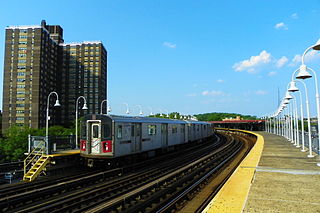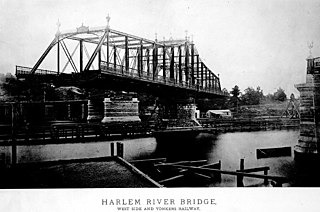
The Interborough Rapid Transit Company (IRT) was the private operator of New York City's original underground subway line that opened in 1904, as well as earlier elevated railways and additional rapid transit lines in New York City. The IRT was purchased by the city in June 1940, along with the younger BMT and IND systems, to form the modern New York City Subway. The former IRT lines are now the A Division or IRT Division of the Subway.

The 167th Street station is a local station on the IRT Jerome Avenue Line of the New York City Subway. Located at the intersection of 167th Street and River Avenue in the Bronx, it is served by the 4 train at all times. This station was constructed by the Interborough Rapid Transit Company as part of the Dual Contracts and opened in 1917.

The IRT Ninth Avenue Line, often called the Ninth Avenue Elevated or Ninth Avenue El, was the first elevated railway in New York City. It opened in July 1868 as the West Side and Yonkers Patent Railway, as an experimental single-track cable-powered elevated railway from Battery Place, at the south end of Manhattan Island, northward up Greenwich Street to Cortlandt Street. By 1879 the line was extended to the Harlem River at 155th Street. It was electrified and taken over by the Interborough Rapid Transit Company in 1903.
The Concourse Line is an IND rapid transit line of the New York City Subway system. It runs from 205th Street in Norwood, Bronx, primarily under the Grand Concourse, to 145th Street in Harlem, Manhattan. It is the only B Division line, and also the only fully underground line, in the Bronx.
The IRT Dyre Avenue Line is a New York City Subway rapid transit line, part of the A Division. It is a branch of the IRT White Plains Road Line in the northeastern section of the Bronx, north of East 180th Street. As of 2013, it has a daily ridership of 34,802.

The IRT Third Avenue Line, commonly known as the Third Avenue Elevated, Third Avenue El, or Bronx El, was an elevated railway in Manhattan and the Bronx, New York City. Originally operated by the New York Elevated Railway, an independent railway company, it was acquired by the Interborough Rapid Transit Company (IRT) and eventually became part of the New York City Subway system.

The White Plains Road Line is a rapid transit line of the A Division of the New York City Subway serving the central Bronx. It is mostly elevated and served both subway and elevated trains until 1952. The original part of the line, the part opened as part of the first subway was called the West Farms Division, and the extension north to 241st Street as part of the Dual Contracts was called the White Plains Road Line. Eventually, however, the two parts came to be known as the White Plains Road Line.
The IRT Jerome Avenue Line, also unofficially known as IRT Woodlawn Line, is an A Division New York City Subway line mostly along Jerome Avenue in the Bronx. Originally an Interborough Rapid Transit Company-operated route, it was built as part of the Dual Contracts expansion and opened in 1917 and 1918. It is both elevated and underground, with 161st Street–Yankee Stadium being the southernmost elevated station. The line has three tracks from south of the Woodlawn station to the 138th Street–Grand Concourse station. The Woodlawn Line also has a connection to the Jerome Yard, where 4 trains are stored, just north of the Bedford Park Boulevard–Lehman College station.

The Harlem–148th Street station is a New York City Subway station on the IRT Lenox Avenue Line in Harlem, Manhattan. It serves as the northern terminal station of the 3 train at all times as well as the Northern terminal of the IRT Lenox Avenue line. The entrance to the station is located at the intersection of 149th Street and Adam Clayton Powell Jr. Boulevard, which has historically been known as 7th Avenue. The station contains a pair of tracks and an island platform and is located at ground level. A parking structure for the adjacent Frederick Douglass Academy is located above the station, forming a roof above the platform and tracks.

The 155th Street station is a local station on the IND Concourse Line of the New York City Subway. It is located at the intersection of the bi-level 155th Street's lower level and Frederick Douglass Boulevard, at the border of Harlem and the Coogan's Bluff section of Washington Heights neighborhoods of Manhattan. It is served by the D train at all times except rush hours in the peak direction and the B during rush hours only. The station opened in 1933, along with the rest of the Concourse Line.

The 161st Street–Yankee Stadium station is a New York City Subway station complex shared by the elevated IRT Jerome Avenue Line and the underground IND Concourse Line. It is located at the intersection of 161st Street and River Avenue in the Highbridge and Concourse neighborhoods of the Bronx. It is generally served by the 4 train at all times; the D train at all times except rush hours in the peak direction ; and the B train during rush hours.
Webster Avenue is a major north–south thoroughfare in the Bronx, New York City, United States. It stretches for 5.8 miles (9.3 km) from Melrose to Woodlawn. The road starts at the intersection of Melrose Avenue, East 165th Street, Brook Avenue, and Park Avenue in the neighborhood of Melrose, ending at Nereid Avenue in the neighborhood of Woodlawn. There are no subway lines along this thoroughfare, unlike the streets it parallels—Jerome Avenue, The Grand Concourse, and White Plains Road, which all have subway lines —but until 1973, Webster Avenue north of Fordham Road was served by the Third Avenue Elevated, served by the 8 train.

The Sedgwick Avenue station was an elevated, ground level and underground station on the Bronx extension of the IRT Ninth Avenue Line in Highbridge, Bronx, New York City.

The Anderson–Jerome Avenues station was an elevated and partially underground station on the Bronx extension of the IRT Ninth Avenue Line in Highbridge, Bronx, New York City.

Sedgwick Avenue is a major street in the Bronx, New York City. It runs roughly parallel to Jerome Avenue, the Major Deegan Expressway, and University Avenue. Sedgwick Avenue is one of the longest streets in the western part of the Bronx, running from Mosholu Parkway at the north to Macombs Dam Bridge at its southern end, about 800 feet west of Yankee Stadium.

The Putnam Bridge was a swing bridge that spanned the Harlem River and the adjacent tracks of the New York Central Railroad in New York City. The bridge connected Harlem in Manhattan to Concourse, near the current location of Yankee Stadium, in the Bronx. It carried two tracks of the New York and Putnam Railroad, and later the 9th Avenue elevated line of the Interborough Rapid Transit Company (IRT), as well as two pedestrian walkways outside the superstructure.















